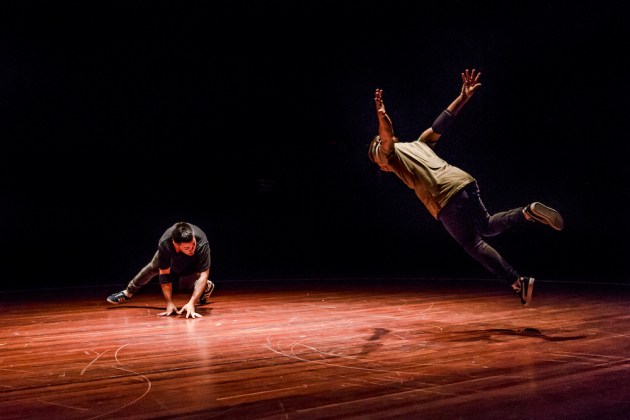Romeo Castellucci (featuring Australian Dance Theatre): Requiem
Festival Theatre, 28 February
Nick Power: Between Tiny Cities
Lion Arts Centre 29 February
Shamel Pitts: Black Velvet
Odeon Theatre. 1 March
Directors Neil Armfield and Rachel Healy like to program a major operatic or choral work as the centrepiece of their Festivals, and this year Romeo Castellucci’s theatrical version of Mozart’s Requiem, the first in a series of co-productions of the Adelaide Festival with the Festival d’Aix-en-Provence, was the opening night production. Featuring Australian Dance Theatre, the Adelaide Festival Chorus and soloists Siobhan Stagg (soprano), Sara Mingardo (alto), Martin Mitterrrutzer (tenor) and David Greco (bass), with the Adelaide Symphony Orchestra conducted by Rory Macdonald in the pit, this is a major production indeed. The production layers a visual dimension onto Mozart’s sublime music, transforming it from an expression of mourning for an individual death to a ritual of grief for humanity and the planet.
Castellucci adds extra music, beginning and ending with Gregorian chant, with other short orchestral pieces by Mozart interspersed throughout, but his major innovations happen onstage. The curtain opens with a middle-aged woman sinking into her bed—a symbolic death perhaps—followed by a series of episodic tableaus featuring the dancers, chorus and soloists. They are accompanied by projected text listing major extinctions over human history, from animal species to buildings to ethnic groups, touching on ecological crisis close to home – Kangaroo Island gets a mention—and ending in generic items that are both touching and absurd, such as the extinction of tears and of wonder.
Meanwhile, a girl is daubed in paint, oil and feathers; the entire cast, decked out in colourful folkloric costumes, performs a lengthy pastoral ritual, including a maypole dance; the cast poses one by one in front of a wrecked car; the paper-coloured walls are sprayed with paint, which is then torn off; finally the entire cast shuffles near naked off the stage and the empty stage is gradually upended, with all of the discarded paper and clothing sliding off into the pit, creating a chilling funereal impression. Had the work ended here, the impact would have been devastating; however, Castellucci undercuts it with a boy soprano singing a hymn and a cutesy scene with a baby. The ADT dancers do not have a lot to do apart from some simple folkloric steps and carting props around, but they must have appreciated the opportunity to work with one of the world’s most revered directors.

On a more intimate scale, Between Tiny Cities is the result of four years of exchange and collaboration between hip hop groups in Darwin and Cambodia. Choreographed by Australian Nick Power, it features performers Aaron Lim from Darwin and Erak Mith from Pnom Penh, with sound design by Jack Prest. The audience is stood up close to hip hop’s traditional ten-metre diameter circle as the dancers, also standing at the circle’s edge, hold each other’s gaze. A gentle piano sounds as they enter the circle, echoing each other’s slow-motion arm movements, which segues into an almost simian running on all fours as the tempo increases and the score becomes percussive. What follows is a hugely engaging conversation in movement that draws on all of hip hop’s standard repertoire of head spins and windmills, coupled with martial arts movements, but also explores the relationship between the performers. At only forty minutes in length, Between Tiny Cities is a delightfully focused and engaging production which expands the theatrical possibilities of hip hop.
Black Velvet is another duet, this time in the contemporary idiom. Israeli choreographer Shamel Pitts danced with the Batsheva Company for many years, and in Black Velvet he performs with Brazilian dancer Mirelle Martins. Both are bare chested, their bodies glistening with bronze metallic paint, highlighting their lean, highly muscled physiques. As the audience enters, Martins is positioned high up on a ladder hidden by a voluminous skirt, her torso picked out by a spot as she rocks her arms from side to side, as if nursing a baby. Her face, initially downcast, comes alive, and she is joined by Pitts when she sheds her skirt and come down to the floor. His movements are rapid and jerky, arms flailing wildly until they form a pair, leaning against each other.

The duet that follows features lots of walking backwards in a square formation, and many static poses interspersed with frenetic running as they separate and come back together into sculptural shapes. The movement palette is more gestural than dance and the work focuses on the emotional phases of their relationship, segueing from aggression to tenderness. However, I found it hard to engage with this performance, partly because of an overlong episode with a ladder, painfully discordant loud music and strobe lighting, and partly because of the racist connotations of the title, which clearly the creators were unaware of, but mainly because I found the dance vocabulary was too thin.
Despite not particularly enjoying the latter, this year’s Festival programming gives a rich overview of the sheer variety of contemporary dance.
Maggie Tonkin
Pictured top is a scene from 'Requiem'. Photo: Tony Lewis


